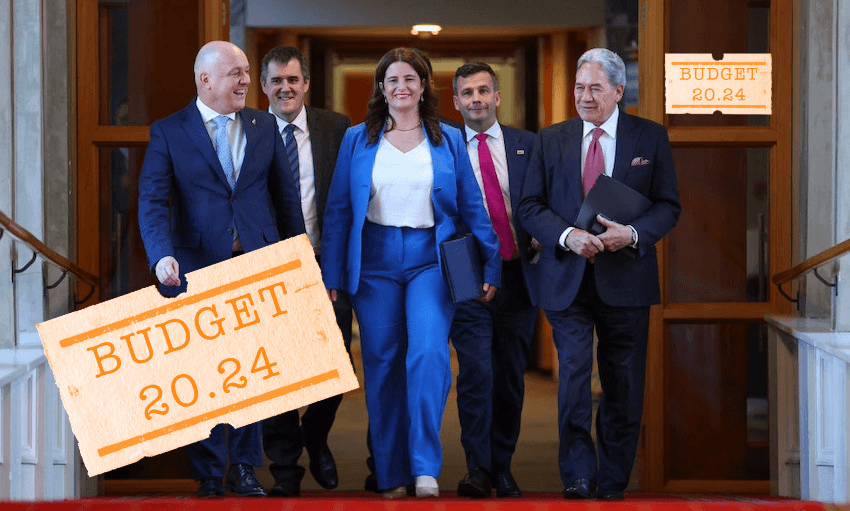The government’s myopic focus on short-term interests – both the taxpayers’ and its own – risks causing long-term damage, warns Max Rashbrooke.
Evidence of a continued addiction to spending? Or, conversely, a slash and burn approach to the public finances? Neither of these rival interpretations of finance minister Nicola Willis’s first budget can be made to stick. What Willis did, in fact, was to craft a short-term hand-out to key political constituencies – while averting her gaze from the increasingly unmanageable long-term pressures building up in the public finances and, by extension, the social fabric.
First off, it is hardly austerity, in a pure sense, when public spending is projected to rise from $138.3bn this year to $156.4bn in 2028. Over the next four years, billions and billions of dollars will be poured into health and education in particular. In the same period of time, government borrowing will be $17.1bn higher than was expected the last time the books were opened. Small wonder the Taxpayers’ Union is not best pleased.
These spending increases, however, are much less impressive than they seem. As the economy grows, the population lifts, inflation increases and needs multiply, government spending has to rise just to keep up. And because the economy is forecast to grow more quickly than state spending, “core crown expenses”, as they are known, will fall from the current 33.5% of GDP to 31.1% in 2028. The state’s share of the economy – its presence in our lives, if you like – will noticeably decline.
This, of course, is still not slash and burn. For around half a century, the working assumption has been that New Zealand governments “naturally” spend around 30% of GDP. And we are not projected to get back to that mark until the 2030s. Again, it is unsurprising that conservatives are cross.
The 30% assumption, though, is a big problem. There is nothing natural about it. To take a few European examples: German governments typically spend around 38%, Dutch ones 40%, and Austrian ones 42%. (And that’s not even counting the tax-loving Scandinavians.) If we taxed at those overall rates, our government would have around $20-30bn extra to spend each year. The Europeans get those funds by levying wealth, capital gains and inheritance taxes, and payroll taxes to boot; in return they get better public services, reduced poverty rates, and more convincing efforts to reduce carbon emissions.
New Zealanders, in contrast, have champagne tastes on a beer budget: we want those high-quality public services, but aren’t – currently – willing to pay for them. And the problems with that approach, which is mirrored in Willis’s ideological determination to (slowly) get spending down to 30% of GDP, are plain to see in this budget.
Take the $16.7bn that Shane Reti proudly proclaims has been allocated to health. Sounds impressive – until one realises that last year, officials estimated $13bn was needed just to maintain current services, and that this year they said the true figure was probably higher. This is known as meeting “cost pressures” or, less formally, “keeping the lights on”: compensating for inflation, allowing for wage increases, and maintaining service levels to an ageing population. Another $1.8bn of the Reti money goes to Pharmac for new drugs. There could be, in short, just a few hundred million each year to improve primary and hospital services in much of our calamitously over-stretched health sector. Some parts of that sector may even find themselves going backwards financially.
It is a similar story in education. A $2.9bn package over four years sounds good, but most of it ($1.5bn) is just to maintain and repair creaking school buildings. The actual operating grants to ECE centres and schools are probably only in line with inflation, broadly speaking – and this in a sector that has been hammered by rising costs in recent years. The much-touted “structural literacy” drive to improve the way children learn to read, meanwhile, gets a grand total of $67m over four years. Again, the funding needed for a real overhaul of a struggling sector – for investment in an array of new programmes and a serious step-change in teaching – is nowhere in sight.
This picture repeats across the whole of the public finances. In the Budget documents, the Treasury warns that the money Willis has set aside for new spending in 2025 and 2026 – $2.4bn in each case – is not even enough to compensate for inflation and maintain existing services. Something, surely, will have to give.
There is, of course, money in the budget to appease the constituencies National thinks are vital to winning again in 2026. Landlords, as well-trailed, get a four-year, $2.9bn tax cut via the restoration of their ability to deduct mortgage interest from their tax bill. Around $10bn will go on raising tax thresholds and expanding the independent earner tax credit. Some $700m is spent on childcare rebates. If you are a middle-income family with kids, and in particular if you also happen to own a rental property, National has your short-term interests covered.
The country’s long-term interests, however, are neglected. Infrastructure spending rises sharply this year, to around $18bn, but falls to under $10bn in 2028, even though the population will grow significantly in that time, and we already have massive under-investment to make up. Because the budget’s “squeezed middle” policies – including tax cuts and raising the in-work tax credit – explicitly exclude beneficiaries and do almost nothing for minimum-wage workers, child poverty rates are projected to rise or, at best, stagnate. Funding cuts will slow Commerce Commission work that could help break up the oligopolies that push up prices and stifle innovation. There is no extra support to help retrain the tens of thousands of people made redundant in our anti-inflation drive. The government seems to have closed its eyes to these long-term realities; it appears unwilling to make the needed investments in our long-term prosperity.
As Willis’s “sinking lid” slowly pushes spending back towards 30% of GDP, in other words, short-term political desires are met – but long-term public needs continue to boil away. As the population ages, the demand – and need – for healthcare spending will grow. Climate change mitigation and adaption – managed retreat, in particular – will demand billions of extra dollars. The lifetime costs of leaving tens of thousands of children in poverty will keep mounting up. The 30% spending target never made sense, but it is getting increasingly unsustainable. Willis looks very much like someone trying to hold down a heavy lid on a huge pot that, heated with ever greater intensity, boils harder and harder, threatening to blow the top right off.


